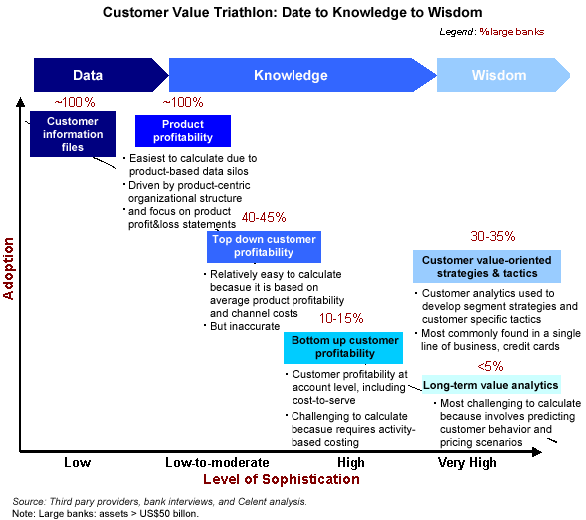San Francisco, CA, USA June 13, 2006
What Are The Best Practice Olympians Achieving?
A strategic shift to customer centricity has banks competing in a new race: a customer analytics triathlon. Celent predicts this new focus will have banks sprinting to master customer data, achieve knowledge, and realize wisdom.
The power of traditional retail banking strategies is waning. Diversification and acquisition strategies are being tapped out, new branch growth is increasingly expensive, and market share is continually being nibbled away by new entrants. Where does the performance power now lie? Celent believes the answer is in customer value management. No small feat, customer value management involves a customer analytics triathlon that begins with mastering customer data, moves to achieving knowledge (extracting insight from the data, e.g., customer profitability), and culminates in realizing wisdom (acting on the insight, e.g., using predictive modeling to improve sub-segment profitability). The triathlon has proven to be an Olympian feat with few in the bank pack able to finish the race today.
In the report, , Celent explores what it takes to be a medalist. To finish ahead, banks must jettison their traditional profitability models and develop a new one based on account level data, which requires gauging cost-to-serve, and most bankers would agree that is an Olympian feat. A feat worthy of attempt, however, given the results banks typically find: over half of their customers' profitability level shifts, and the shift can be as great as three deciles. The shift is driven largely due to variations in customers' cost-to-serve. For example, a customer that consumes "live" channels (branch and call center) can cost five times and more to serve than one reliant on remote channels.
"Although a majority of banks would say yes to the question "do you calculate customer profitability," most would have to qualify that they do not calculate it at the account level but instead use averages. Averages do not win the race. To get on the podium, a bank must calculate account level profitability and roll these up to the customer level," says Alenka Grealish, author of the report and manager of the Banking group at Celent. "Customer value management is not a one shot achievement but rather involves a long learning curve and results in cumulative improvements. Consequently, banks that are today's winners will likely be tomorrow's winners, while the losers will be increasingly behind. The winners will excel in identifying product opportunities in sub-segments, in reducing product development times, and overall in raising the bar on customer satisfaction and loyalty," she adds.

This report discusses the achievements of two medalists: Royal Bank of Canada and Washington Mutual.
The report is 33 pages and contains 13 figures and 8 tables.
A table of contents is available online.





